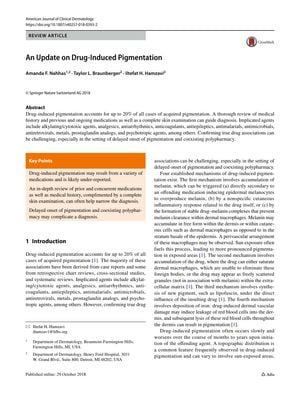An Update on Drug-Induced Pigmentation
October 2018
in “
American Journal of Clinical Dermatology
”

TLDR Some drugs can cause skin and hair color changes, often reversible when the drug is stopped.
The 2018 review article discusses drug-induced pigmentation, which accounts for up to 20% of acquired pigmentation cases. It highlights the need for a thorough medical history and skin examination to diagnose this condition. Various drugs, including alkylating agents, analgesics, antiarrhythmics, anticoagulants, antiepileptics, antimalarials, antimicrobials, antiretrovirals, metals, prostaglandin analogs, and psychotropic agents, can cause pigmentation through mechanisms such as melanin accumulation, drug accumulation, new pigment synthesis, and iron deposition. Pigmentation usually develops slowly and may not fully resolve even after stopping the drug. The review cites a study of 103 patients on amiodarone, with 8% developing hyperpigmentation after over 20 months, and a systematic review of 8,052 patients across 36 trials, showing a 17.7% incidence of pigmentary changes in the skin and 21.5% in the hair due to targeted cancer therapy. The document also details specific drugs and their pigmentation effects, incidences, and mechanisms, emphasizing that most changes are reversible upon drug discontinuation.





